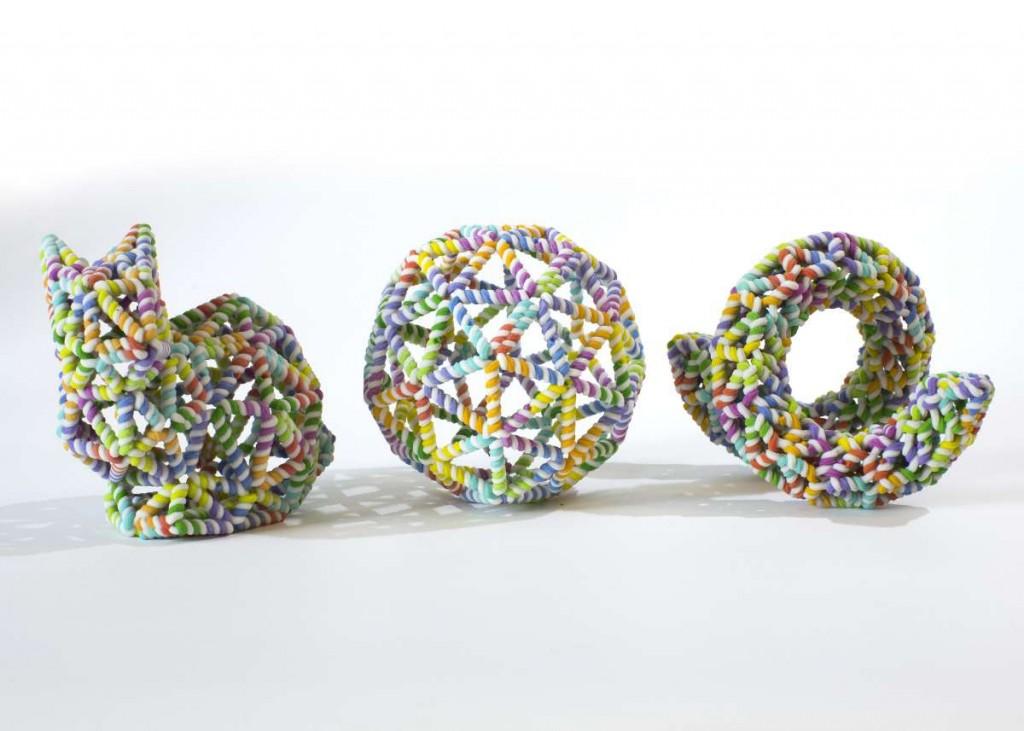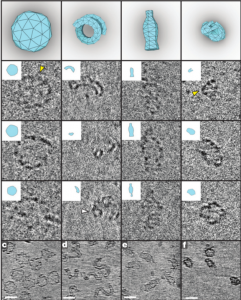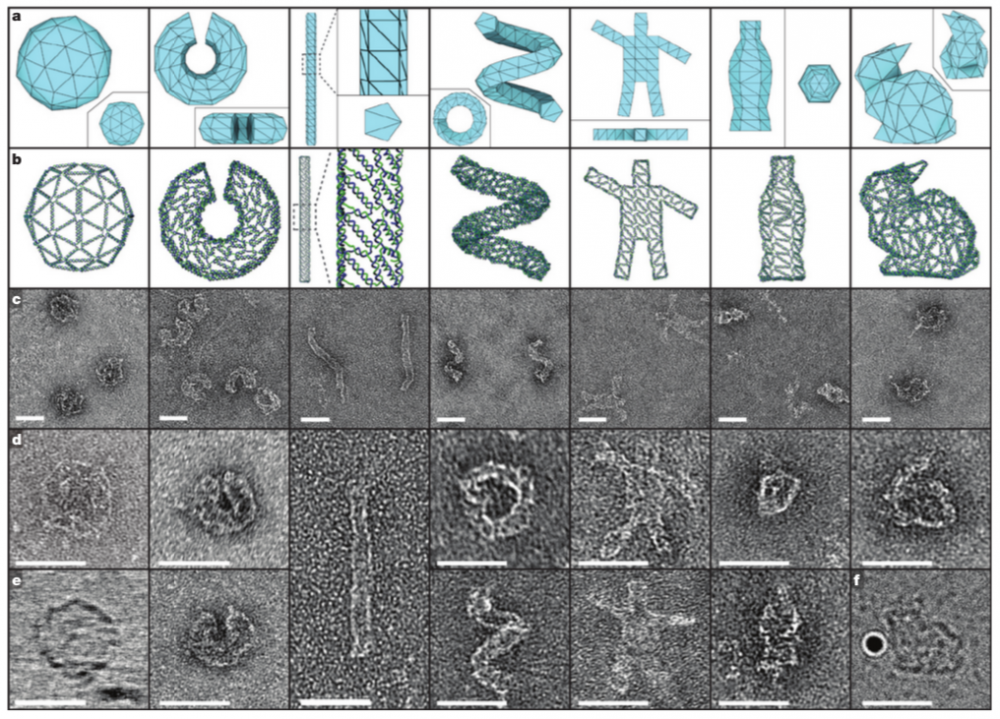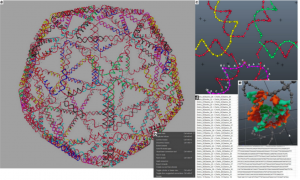A group of Swedish researchers have developed a method to create nanoscopic constructs and shapes made entirely out of a single strand of DNA. The first, and most obvious question here is ‘why would you want to 3D print a strand of DNA shaped like, say, a bunny or a donut?’ The primary usage would be to create DNA-sized structures that could interact with human cells and the various molecules that they are made of. These structures could be engineered to deliver life saving drugs or nutrients to the human body, with the shape determining how and even when they are absorbed into the body.
This could lead to life saving cancer treatments potentially capable of shutting down a cancer cell’s ability to grow as well as corrupt surrounding tissue. These constructs could also be used to deliver drugs that would be attracted to a specific part of the body and only affect that area rather than potentially damaging surrounding tissue. This method of folding DNA has been dubbed “DNA origami”, and while it isn’t the first method devised to create nanoscale DNA constructs, it is widely considered the most versatile and streamlined method devised.
“3D DNA origami has traditionally been implemented using close-packed helices that can yield solid brick-like shapes that are both impressive and visually appealing when imaged using dry-state negative-stain transmission electron microscopy. But emerging work that utilizes DNA origami in biological research, where qualities such as stability in low-salt conditions and structural flexibility are important, has favoured one-layer, hollow structures. The new design paradigm we report here, using double helices alone as structural elements instead of close-packed bundles of helices, alleviates the need for nonphysiological concentrations of salts completely, and is expected to enable more experiments in cell biology and potentially also in vivo, with a closer match between conditions in the model system and the true biological context,” explained the researchers in their paper published in science journal Nature this week.
The paper’s lead author Dr. Bjorn Hogberg and his team of researchers have been able to construct several shapes and configurations, including balls, rods, a bottle shape, a human shape and even the shape of a rabbit. Coming in at less than 100 nanometers (0.0001mm) across, these DNA constructs are impossibly tiny. Sadly, amateur DNA designers won’t be creating complex nanoscale DNA objects any time soon. While they are easy to design, actually printing them out takes more resources than anyone but a professional research lab will have access to. However Hogberg’s team has still released the complete algorithm code in the hope that other labs will be able to simplify the process.
“The learning curve is really improved here, it’s really easy to design [3D DNA structures] now. But creating them hasn’t really changed. To actually get them printed out, you have to order the DNA and pipette it together, and that’s of course the barrier to entry for most people,” algorithm told The Washington Post.
The process involves inputting a desired shape into a computer algorithm that is capable of calculating the most efficient way of folding a long, continuous strand of DNA into a specific shape. Then, short strands of DNA are used essentially as sutures to bind the longer strand of DNA into that shape and hold it in place. These DNA staples are constructed to include two DNA sequences that will match specific points on the longer strand of DNA. These sequences will be attracted to each other and will bond with the longer strand, holding them together as a stable microscopic biomedical construct.
DNA Origami is so simple, that once the shape has been chosen, they will virtually construct themselves with little to no human intervention. The computer algorithm simply provides a list of the various types of DNA strands required to create the desired 3D object. Then that list can be sent to a lab where the individual strands of DNA will be synthesised. Finally, all of the DNA strands can be mixed together and they will simply self-assemble based on the matched sets of sequences designed to bond to each other.
The algorithm that renders the strands of DNA was developed by Hogberg’s team at the Karolinska Institute in Sweden, with the help of a team from Aalto University in Finland. Together they discovered that these single strand, dynamic shaped DNA constructs are the ideal structure to fully interact with the body on a molecular level. In order to be able to easily create these shapes, they used the nature of DNA to mimic polygonal 3D shapes that are used in computer designed 3D models. Not only is it more effective, but the shapes are easy to generate using basic 3D design and 3D printing software.
Let us know what you think of this exciting nanoscale 3D printing process over in our 3D Printing Using Strands of DNA forum thread on 3DPB.com.
Subscribe to Our Email Newsletter
Stay up-to-date on all the latest news from the 3D printing industry and receive information and offers from third party vendors.
Print Services
Upload your 3D Models and get them printed quickly and efficiently.
You May Also Like
Havaianas Collaborates with Zellerfeld to Launch 3D Printed Flip-Flops
The shoe of the summer is undoubtedly the flip-flop. Easy on, easy off, your feet won’t get sweaty because there’s not much material, and they’re available in a veritable rainbow...
UCLA Researchers Develop 3D Printed Pen that May Help Detect Parkinson’s Disease
Diagnosing Parkinson’s disease is difficult. Often, early symptoms of the progressive neurological condition may be overlooked, or mistaken for signs of aging. Early diagnosis can help save lives and improve...
Printing Money Episode 30: Q1 2025 Public 3D Printing Earnings Review with Troy Jensen, Cantor Fitzgerald
Printing Money is back with Episode 30, and it’s that quarterly time, so we are happy and thankful to welcome back Troy Jensen (Managing Director, Cantor Fitzgerald) to review the...
Heating Up: 3D Systems’ Scott Green Discusses 3D Printing’s Potential in the Data Center Industry
The relentless rise of NVIDIA, the steadily increasing pledges of major private and public investments in national infrastructure projects around the world, and the general cultural obsession with AI have...




































